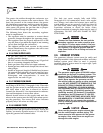
32 Generac
®
Power Systems, Inc.
2.7.2 WIRING
• Wiring should be of stranded copper to reduce the
chance that vibration may cause breakage.
• Wire gauge size should be large enough to handle
at least 115 percent of the installed generator's
rated maximum current.
• If neutral conductors are used, they must be the
same size as other leg wires.
• Route power supply conductors from generator AC
output leads T1 (red), T2 (white), T3 (black) and
the green ground wire through approved flexible
conduit to the electrical junction box on the com-
partment wall.
If flexible metal conduit is used between the genera-
tor and the compartment junction box, the conduit
end that terminates the compartment junction box
must be vapor-sealed. Flexible metal conduit is NOT
vapor tight along its entire length.
• From the junction box, route power supply wires
through approved conduit to either (a) double-pole,
double-throw transfer switch, or (b) approved isola-
tion receptacle. Connecting to a transfer switch or
isolation receptacle must prevent vehicle electrical
circuits from being connected to two different power
supplies at the same time (such as generator and
dockside power).
• Conductors must be rated 221° F (105° C) or must
be of a larger conductor size.
2.7.3 GENERATOR AC CONNECTIONS
Generator AC output leads T1 (red), T2 (white) and
T3 (black) come out of the generator as shown in
Figure 2.17. Leads T1 (red) and T3 (black) are “hot,”
while T2 (white) is the grounded neutral lead. There
is also a green lead that connects to ground in the
junction box of the recreational vehicle.
Figure 2.17 – Generator AC Output Leads
Line T1 (red) to T2 (white) is protected against over-
load by a 30-amp circuit breaker (CB1). Use this line-
to-neutral connection separately to operate 120-volt,
single-phase, 60 Hertz, AC loads requiring up to 3,600
watts (3.6 kW) of power. Line T3 (black) to T2 (white)
also is protected against overload by a 20-amp circuit
breaker (CB2). Use this line-to-neutral connection sep-
arately to operate similar loads. However, be sure the
total unit load does not exceed the maximum rating of
the generator. The neutral line (T2, white) on all units
is a grounded neutral.
Do NOT connect electrical loads in excess of any
circuit breaker rating or you will develop prob-
lems with circuit breaker tripping, which causes a
loss of AC output. Also, do NOT exceed the gen-
erator's rated wattage capacity. Add the watts or
amperes of all lighting, appliance, tool and motor
loads the generator will operate at one time. This
total should be less than the unit's rated
wattage/amperage capacity.
2.7.4 CONDUIT
Route the connections between the generator and the
junction box through approved, flexible conduit. The
following general rules apply:
• Cut wiring to the required length and allow extra
wire for junction box connections.
• Carefully prepare conduit ends to prevent sharp
edges from cutting through wiring insulation.
• Route conduit so it does not interfere with genera-
tor movement.
• If you use metallic conduit, vapor seal the end of
the conduit where it enters the junction box. Do
this because flexible metallic conduit is not vapor-
proof along its entire length.
2.7.5 ISOLATING DIFFERENT POWER SOURCES
Connections from the junction box must terminate in
a double-pole, double-throw transfer switch (Figure
2.18, Page 33). An alternate method for isolating dif-
ferent power sources is by using an isolating recepta-
cle (Figure 2.19, Page 33). Whichever method you
use, you must be certain that both power sources are
NOT connected at the same time.
◆
◆
T3
T2
T1
Green
(Ground)
◆
◆
Section 2 – Installation
PRIMEPACT 50 Recreational Vehicle Generator


















